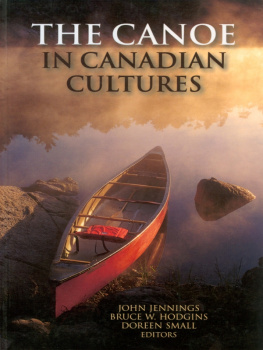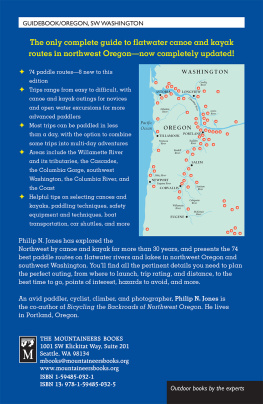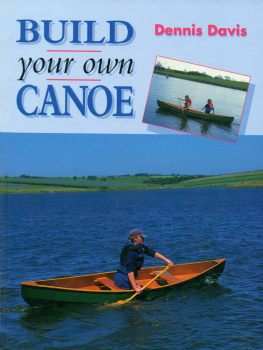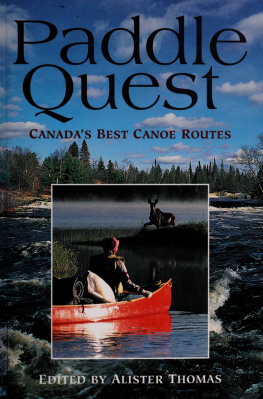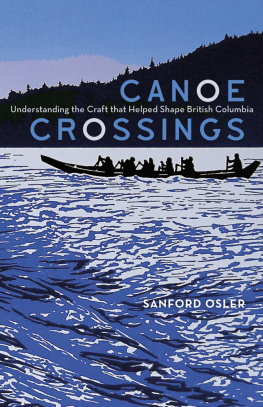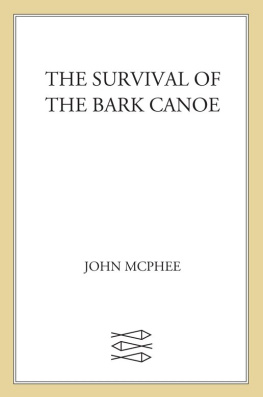
THE CANOE IN CANADIAN CULTURES

FOREWORD
Kirk Wipper
PREFACE
John Jennings and Bruce W. Hodgins
EDITORS
John Jennings
Bruce W. Hodgins
Doreen Small

NATURAL HERITAGE/NATURAL HISTORY INC.
Copyright: Essays 1999 Individual authors.
Copyright: Edition 1999 Natural Heritage Books.
All rights reserved. No portion of this book, with the exception of brief extracts
for the purpose of literary or scholarly review, may be reproduced in any form
without the permission of the publisher.
John Jennings, Bruce W. Hodgins, Doreen Small, Editors
Second Printing May 2001
Canadian Cataloguing in Publication Data
The canoe in Canadian cultures
Includes bibliographical references and index.
ISBN 1-896219-48-9
1. Canoes and canoeing Social aspects Canada.
2. Canoes and canoeing Canada History. 3. Fur trade Canada.
4. Voyageurs.* I. Hodgins, Bruce W., 1931 - . II. Jennings, John, 1941 - .
III. Small, Doreen.
VM353.C345 1999 386.229 C99-930517-4
Front photo: Early morning on the French River (canoe from a Temagami out
fitter). Photographer, Toni Harting.
Back cover: Top: High water on the French River. Artist, Neil Broadfoot.
Lower left: Nootka whaling dugout canoe, early nineteenth century.
Photographer, Michael Cullen.
Lower right: Early nineteenth century western Arctic baidaraka model, with
loops for hunting implements. Figures are wearing ceremonial costumes.
Photographer, David Rankin.
Cover design by Blanche Hamill, Norton Hamill Design, Toronto.
Text design/production by Gringo Design, Toronto.
Printed and bound in Canada by Hignell Printing Limited, Winnipeg,
Manitoba.

Natural Heritage/Natural History Inc. acknowledges the support received for its publishing program from the Canada Council Block Grant Program. We also acknowledge with gratitude the assistance of the Association for the Export of Canadian Books, Ottawa.
TABLE OF CONTENTS
1. THE CANADIAN CANOE MUSEUM AND CANADAS
NATIONAL SYMBOL
John Jennings
2. BEING THERE: BILL MASON AND THE CANADIAN
CANOEING TRADITION
James Raffan
3. EXTREMELY CRANKY CRAFT: THE JAMES W.TYRELL KAYAK,
BIG ISLAND, HUDSON STRAIT
Kenneth R. Lister
Eugene Arima
Bert Horwood
Adrian Lee
7. THE CANOT DU MATRE:
MASTER OF THE INLAND SEAS
Peter Labor
8. MANUFACTURE OF BIRCHBARK CANOES FOR
THE FUR TRADE IN THE ST. LAWRENCE
Timothy Kent
9. THE REPRESENTATION OF ABORIGINAL CULTURE WITHIN THE
CANADIAN CANOE MUSEUM
Shanna Balazs
10. CANADIANS AND THE CANADIAN CANOE IN THE
OPENING OF THE AMERICAN MIDWEST
Ralph Frese
11. PADDLING VOICES: THERES THE POET, VOYAGER,
ADVENTURER AND EXPLORER IN ALL OF US
Alister Thomas
Bob Henderson
Toni Harting
Gwyneth Hoyle
Kirk Wipper
Becky Mason
17. THE CANOE AS CHAPEAU: THE ROLE OF THE
PORTAGE IN CANOE CULTURE
Bruce W. Hodgins
David Finch

I n the interval between the first Canexus Conference at Queens University in 1988 and Canexus II, held at Trent University in 1996, much has happened. It is rewarding to review what has transpired in so many directions in the world of paddling in Canada, the essence of which is captured so ably through the range and depth of the essays in this volume.
The Canadian Canoe Museum, under the banner of a Museum in the Making has moved sharply forward with its carefully planned objectives. In all cases of this the public has responded enthusiastically to the developments taking place. The specimens now on display in the Garfield Weston National Heritage Centre in the Museum have captured the imagination of many visitors, near and far. Shortly, an original Hudsons Bay Post will be installed to add to the interpretation of a unique and colourful Canadian heritage. A talented staff, led by Bill Byrick, the Museums Executive Director, along with a dedicated Board of Trustees, an Advisory Council and an outstanding corps of volunteers are responsible for the excellent progress made in this major project.
The Canadian Recreational Canoeing Association now has a home in Merrickville to provide improved service in canoeing and kayaking across the nation. National standards are in place. An inclusion program for the disabled has been presented under the slogan, Canoeing and Kayaking is for Everyone. Innovations have been developed for those who have not been included in the paddling fraternity. The Flame of Hope is for urban youth who, through this program may paddle with police, firefighters, ambulance workers and emergency task force members. This program contributes to a much better understanding and appreciation of other community members.
The Canadian Heritage Rivers System and Rivers Canada have made important inroads into the preservation of nominated rivers across the country. This program is significant not only for contemporary users of those rivers, but especially for future generations who will be assured of cultural and wilderness experiences of high quality.
Media attention is at an all time high. Films, videos, radio commentaries, newspapers, magazines and journals and advertising have all focused on the canoe and kayak in a variety of ways. Authors, too, are devoting attention to small watercraft making this Canexus publication most timely as it is about to be made available to the public.
A number of intriguing watercraft designs have emerged in the paddling world. Craft for slalom, coastal paddling and all forms of competitive water activity are but a few examples of such proliferation. The rocker canoe has been introduced again for white water activity. These craft may be related to the birchbark canoe of aboriginal origin. Propelling devices also have become diversified and include the increasingly popular bent shaft paddles and poles, as well as the employment of new materials including graphite, metal and fibreglass.
The virtual explosion of the use of fur trade replica canoes, the canot du nord (North Canoe) and the canot du matre (Montreal Canoe), have given to paddlers a group experience which has, for many, a singular attraction. In these large watercraft, one can begin to feel something of the pulse of the fur trade. The introduction of Dragon Boats also presents a group paddling experience in the competitive realm of canoeing.
Re-enactments of historic events, festivals and pageants have become an important means for interpreting and experiencing the story of Canada. Some examples of historic figures that have been featured are: Alexander Mackenzie, David Thompson, Simon Fraser, and John Graves Simcoe. These portrayals give the public a new insight into what has gone on before.
Outfitters across the nation have become much more visible in the cultivation of skill and safety sensitivity as they present a broad range of adventurous experience in outdoor places. My own recent experiences with outfitters have given me a renewed enthusiasm for the welfare of the environment we use in our journeys into the wilderness. They are demonstrating in their practices a real difference between adventure and sheer foolhardiness. Today, there are, fortunately, more reliable outfitters by far than when the first volume of Canexus was published. According to all reports, they are making a distinguished contribution to paddling in Canada.
Next page
